Bond features
Appearances
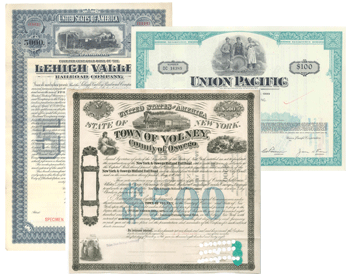
Bonds are normally larger than stocks. They average roughly 9 by 13 inches with some of the largest bonds up to 27 inches square. Early bonds were usually larger than later ones.
Bonds always show monetary values. Over 60% of recorded bonds are $1,000 bonds. Five hundred dollar bonds were the next most popular denomination. From the remainder is a wide array of printed denominations ranging from $2 to $39,930,000.
Authorized amounts
Around 35% to 40% of bond varieties display language that explains how much money boards of directors authorized their companies to borrow. Most of the time, authorizations were expressed in hundreds of thousands or millions of dollars. If a company authorized a bond issue of $1,000,000 in bearer bonds and intended to issue only $1,000 bonds, then the company probably printed 1,000 bonds plus some number of extras. That does NOT necessarily mean companies sold all – or any – of those authorized bonds.

If a company issued several denominations of registered bonds, there is probably no way to calculate how many bonds were printed, let alone issued. Good estimations of total debt can be acquired through industry magazines and manuals.

Companies developing lines into new territories, whether in the American West, the Canadian woods, or along the populated East Coast, were frequently uncertain of conditions they might encounter. Lands might have been too rugged or too swampy, or maybe it was too hard to anticipate land acquisition costs and or ever-changing governmental restrictions. Instead of authorizing overall expenditures, companies frequently stated their authorizations in terms of dollars, pounds, or pesos per mile.

Collectors dying to know how many certificates are still out there need to ask how we are ever going to estimate survivorship. Just because a company authorized the issuance of 10,000 bonds does not mean any still exist. It is probably wise to ignore the quest for precise numbers and turn instead to discovering how frequently desired certificates appear for sale. If collectors still think loan amounts are somehow indicative of certificate availability, they are advised to consult various issues of Poor's Manual of the Railroads of the United States for examples of issuance statistics like the example shown above.
"Bearer bonds" versus "registered bonds"
North American investors normally purchased bonds in units of $1,000. That was a LOT of money in the early 1800s. Like ordinary currency, security of ownership was generally considered to be the responsibility of bondholders. Taxation of profits was not an initial issue of concern at the time, so neither companies nor governments kept track of individual bondholders. With few exceptions, bonds were considered "bearer" instruments. That meant that whoever held a bond was considered its rightful owner.
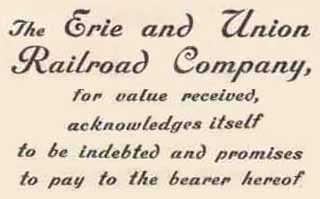
There was also an inescapable cultural reality to consider. Only the richest individuals could afford to invest in bonds and they had both the financial means and incentives to protect their holdings.
Inflation, however, was and remains a relentless force of nature. Over time, inflation devalued dollars, pounds, and pesos and allowed ever-increasing numbers of people to participate in the concept of having their money work for them while they slept. Regardless of whether ordinary people invested in bonds directly through personal purchase or indirectly through savings accounts at banks, the need grew for greater security.
Physical bonds could be secured in safes, of course. Still, it was difficult to prove ownership of bearer bonds lost to fires, floods, and earthquakes even if they had been stored in safes. Truly secure proof of ownership would have required redundant record-keeping by both investors and companies. Doing so was limited by cumbersome, slow, expensive, and often unreadable handwriting. Even from the earliest sales of bonds in North America, a few companies "registered" ownership of their bonds, but the vast majority did not. It was not until the late 1880s that typewriters penetrated most corporate offices and finally allowed an effective way to record bond ownership.
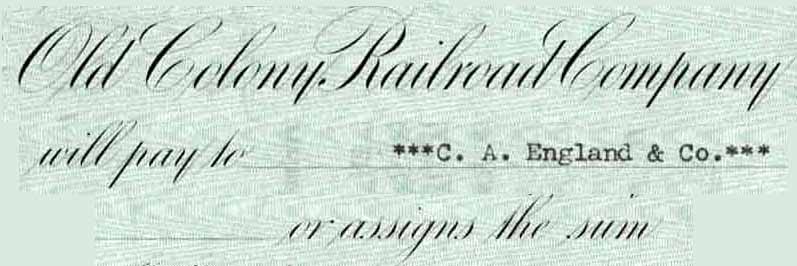
That simple technological advance gave companies the ability to communicate with bondholders more effectively than through publication of notices in newspapers. Moreover, it allowed companies to pay periodic interest to bondholders directly. Registered bonds freed investors from the thankless task of dealing with small and easily lost coupons, so the acceptance of registered bonds increased radically from the 1880s into the 1890s. However, even the increased security of registration was insufficient for huge numbers of bondholders who continued to insist on using coupon bonds because of the freedom it gave them when buying and selling.
As the economy grew and the market for bonds expanded, so did technology. Arguments against company intervention and slow turnaround times slowly evaporated. Moreover, the government liked registration because it gave greater ability for tracking interest income. With the tremendous growth in the drug trade in the late-1960s and onward, bearer bonds took on an unintended role as a de facto, high-value currency. The U.S. government eventually forced bearer bonds from the market in 1982.
"Bearer bonds," "coupon bonds," and "registered bonds"
Bearer bonds and coupon bonds are ALMOST synonymous. That means that almost all bearer bonds had coupons and almost all coupon bonds were bearer bonds.
Proof of ownership
The bearer designation indicates the only proof of ownership necessary to collect interest or redeem bonds for principal. An issuing entity would pay interest or principal to anyone who presented a bearer bond for redemption. Conversely, if the bond were registered, an entity would make payments only to specifically-registered persons, companies, partnerships, or other entities (city, town, state, etc.) Registration was a way to insure that rightful owners remained owners until they sold their bonds.
Conversion from bearer status to registered status
Conversion between ownership types was often possible when companies issued both bearer and registered bonds. Collectors can often see proof of convertibility deep in the text on the fronts of many bonds. Evidence of those changes are fairly rare and usually goes unnoticed by collectors. However, the backs of many bearer bonds show special places for recording conversion,
 The back of the bond above shows conversion from bearer to registered status on November 3, 1899. The officially registered owner was the "Treasurer and Receiver General of the Commonwealth of Massachusetts in Trust for the Reliance Marine Insurance Company, Limited of Liverpool, England for the security of all the policy holders of said company in the United States." Sometime afterwards, the insurance company sold the bond. The new owner converted the bond back to bearer status on May 31, 1927.
The back of the bond above shows conversion from bearer to registered status on November 3, 1899. The officially registered owner was the "Treasurer and Receiver General of the Commonwealth of Massachusetts in Trust for the Reliance Marine Insurance Company, Limited of Liverpool, England for the security of all the policy holders of said company in the United States." Sometime afterwards, the insurance company sold the bond. The new owner converted the bond back to bearer status on May 31, 1927.
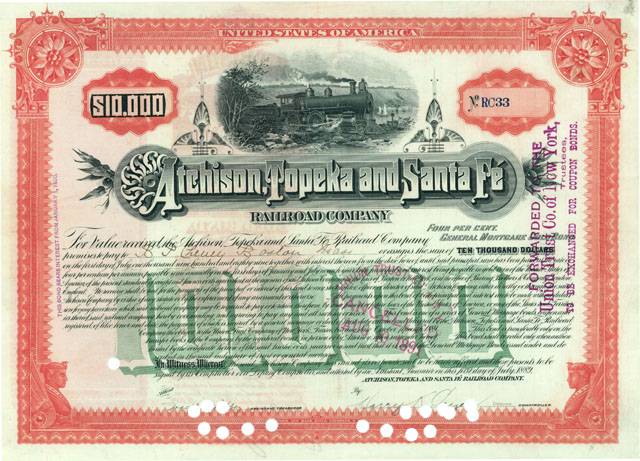
At right is a registered bond that was exchanged for ten coupon coupon bonds two years after its issuance in 1889. At the right side is a rubber stamp impression that says, "FORWARDED TO THE Union Trust of New York Trustees, TO BE EXCHANGED FOR COUPON BONDS." Several bonds of this series show similar exchanges, although many rubber stamp impressions are lighter than this one.
Method of collecting interest
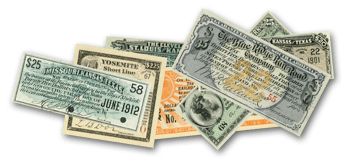
Coupon bonds had small "interest warrants" attached that were redeemable for periodic interest payments. The majority of bonds paid interest every six months (semi-annually.) Investors could carry or send coupons directly to companies for payment or could redeem them through brokers, banks, and trusted individuals via powers of attorney.
Companies paid interest on "registered bonds" on the same schedules, but directly to bondholders, without the hassle of dealing with and cancelling thousands of coupons every six months.
Obvious differences between registered, bearer, and coupon bonds
- Registered bonds always have a space for the bondholder's name.
- Bearer bonds are easily identify by the presence of coupons if still attached. Otherwise look for phrases in the text like "attached coupons" or "annexed interest warrants." All but a very few coupon bonds were bearer bonds.
- Bearer bonds always indicate payment was due to the bearer. Many stipulated that they were payable to an important person, company or bearer.
Currencies
Bonds indicated payment in gold coinage, silver coinage, or "lawful money." When payable in currency, they stated the national currency to be used to pay interest and repay principal.
Bonds that financed North American railroads generally promised to repay in United States dollars, Canadian dollars, and less frequently Mexican pesos. Units of several European currencies are also mentioned, usually in conjunction with two or more additional currencies including:
- florins
- francs
- pesetas
- pounds
- reichmarks
Color
The three most popular colors of bond borders are black, green, and brown in that order. Together, those three colors account for two-thirds of all bonds currently reported. Colors were used sparingly in the earliest days of railroading in North America and most bonds were monocolor black until after the Civil War (1865). Colored borders and underprints became increasingly popular from that point forward, ultimately serving as an added level of security against counterfeiting.
This project has never found a relationship between color and denomination.
Denominations
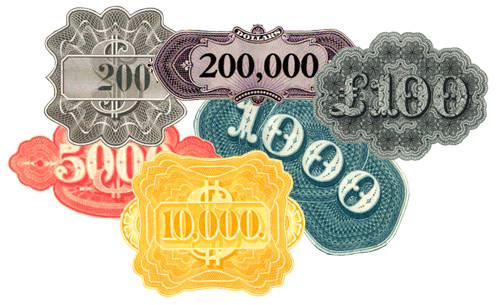
The most popular bond denomination is $1,000 and accounts for over 60% of all railroad bond varieties currently recorded. All told, this project has recorded over 150 different bond denominations.
Six denominations account for 92% of all collectible bonds identified..
| ▪ |
$1,000
|
60.3%
|
| ▪ |
$500
|
11.2%
|
| ▪ |
$100
|
6.0%
|
| ▪ |
$odd
|
5.4%
|
| ▪ |
$5,000
|
5.1%
|
| ▪ |
$10,000
|
4.6%
|
Million-dollar and multi-million dollar bonds are perennially popular, but are represented by fewer than 35 varieties. Over half are known only in specimen form.
Format
Bonds were printed in three formats:
- horizontal format: text readable across the wide dimension of paper ("landscape" in modern computer parlance)
- vertical format: text readable across the narrow dimension ("portrait")
- square format
Bonds have been printed in all three formats from the earliest days of bond issuance, although square format bonds seem to have disappeared after the 1870s. A tally of extant collectible bonds shows that the overwhelming majority of bonds dated before the 1880s were printed in horizontal formats. During that period almost all had coupons attached. Coupons and bonds were normally printed on the same piece of paper with coupons generally printed below bonds. Placement of coupons were highly variable, however, with coupons sometimes completely surrounding bond certificates.
Vertical format bonds were not popular before the 1880s. The earliest railroad bond currently reported was issued in 1833 in horizontal format by the Petersburg Rail Road Co. Between then and 1879, over six times as many bonds were printed in horizontal formats as in vertical formats. Curiously that fifty-year trend changed suddenly, and vertical format bonds prevailed during the 1880s at a ratio approaching three-to-one. That trend continued through the 1970s until bearer bonds were forced out of existence (in the U.S.) in 1982.
I have never found a definitive explanation for the switch. However, I suspect it may have something to do with coupons, bond terms, and invention.
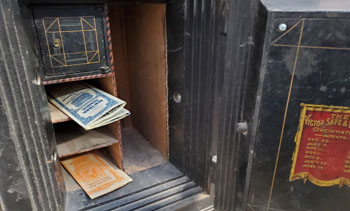
Through the 1870s, most bonds were issued with 20-year and 30-year terms. The average term almost exactly 25 years. At two interest payments per year, 25-year bonds needed fifty coupons.
Fewer than fifteen bonds are known from the 1870s are known with terms of fifty years or longer. Almost 350 are known from the 1880s. Average bond terms jumped from 25 years to 43 years during that decade, so bearer bonds needed many more coupons. Hundred-year coupon bonds would have needed two hundred coupons, far too many to easily print on single sheets of paper.
The obvious solution was to print coupons on separate sheets. Unfortunately, there were few practical ways to keep bonds and coupons together.
Enter the stapler.
There had been a few precursors, but the first true patents for stapling documents together with wire were not issued until 1877. It took another two years for the first commercially successful stapler to start moving into offices across North America.
Size was also important. The huge bonds common before the 1860s had to be folded multiple times for storage in typical office desks and small safes like shown above. By printing coupons separately and stapling them to smaller sized bonds, investors could fold bonds in thirds and store them easily.
Interest
Bonds always stipulate annual interest rates, usually payable semi-annually (every six months). Interest rates reflect the financial climate at the time of issuance: less interest during times of financial stability and limited inflation; d more during times of tight money and high inflation. The more stable and profitable the company, the smaller the interest premium offered above national average. Riskier companies and those with adventurous expansion plans had to pay higher interest rates in order to attract investors.
Collectors will regularly encounter bonds in the range of 4% to 6%. Once interest rates hit levels of 7% or more, the greater the drag on growth and the greater the chances of non-payment. Companies always wanted to offer bonds with the lowest possible interest rates, but it was difficult to fine-tune interest rates to meet investors' desires. Consequently, whole-number interest rates (i.e. 4%, 5%, 6%, and 7%) are significantly more common than fractional interest rates.
With almost two-hundred years of railroad bonding history, collectors can find bonds with interest rates that have ranged from 0.5% to 15.63%.
Par value

Par value is the stated denomination on the face of a bond. It represents the amount of money that would be repaid on and after the date of maturity.
Market value
The market value of bonds, whether buying or selling, is a function of face value, interest rate, and term (the time unto principal is repaid.) Investment strategy takes in those factors of course, but always against a backdrop of competing opportunities and views of the future.
$1,000 6% 20-year railroad bonds were quite typical throughout the 1870s. Such bonds would have paid $30 in interest every six months for nineteen and a half years. At the end of the 20th year, those bonds would have repaid $1,000 in principal plus $30 for the final interest payment. Over that twenty year span. a bondholder would have received $2,200 on an initial investment of $1,000. That kind of return on a $1,000 investment sounds "okay." At least at first blush.
Unlike savings accounts that compound interest on a monthly or even daily basis, corporate railroad bonds paid constant, "simple" interest every six months. (Extremely few paid quarterly.) Interest payments like that are merely rental payments on money lent.
Payments on typical amortizing home loans pay both interest and some principal monthly, Railroad bonds did not repay any principal until the end of loan periods. That means the entire amount of investor money loaned remained at risk until the stated day of redemption.
Unlike interest-bearing savings accounts and certificates of deposit, interest on railroad bonds did NOT compound. Whereas an investment in a 6% $1,000 railroad bond would have netted $1,200 in interest over twenty years, investing $1,000 in an ordinary savings account earning compounded 3.96% interest would have earned the same amount. If compounded daily, a savings account earning 3.94% would have equaled the railroad bond.
To be fair, high quality corporate bonds generally paid interest 4% higher than typical savings accounts, so railroad bonds should have out-performed savings accounts. Furthermore, savings accounts were not Federally insured before January 1, 1934. Nonetheless, it is important to appreciate that there are significant differences in "yield" between investments paying simple interest and those paying compound interest.
The other reality to accept is that investors live in a world of competing opportunities and every opportunity is darkened a bit by the reality of inflation. The effect of inflation on investment yield is like driving a car into a head wind while riding the brakes. If drivers want to go faster (investment yield), but can't push harder on the accelerator (fixed interest payments), they need to let up on the brakes (the amount they initially pay for investments.)
If investors are going to receive fixed rental payments every six months and are going to receive known amounts of money at redemption, then the less they lend out, the more they will improve their yields. Using the current example, we know that if investors paid $1,000 for a brand new bond with a face value of $1,000, they would earn 6% in simple interest over twenty years. However, If they lent only $893 to get a $1,000 bond, their effective yield would rise to 7%. Decreasing the price further to $802 would increase their yield to 8%, and so forth.
It is therefore important for collectors to realize that not all bonds were sold at face value. Bonds are bought and sold constantly in the open market place, with prices fluctuating constantly with the near-infinite interpretations of news, fear, and greed. Perhaps the single largest factor affecting price is the guess by the very next buyer of how much risk they are taking. They are always asking, "Is the company going to pay off its bonds or not?" Believe it or not, the vast majority of railroad companies failed to pay off some of their bonds at one time or another.
Recent certificates
With a few notable exceptions, there are limited numbers of collectible bonds dated after the mid-1950s. Collectors will generally encounter bonds issued from the 1850s into the 1890s.
Serial numbers
Most companies serial-numbered each of their bond issues in sequence from one upwards regardless of the various denominations it might have issued. A few companies numbered each denomination separately, starting with #1 and a letter prefix. The letters often included the letters L, C, D and M, Roman numeral abbreviations for 50, 100, 500. and 1,000 respectively. Collectors commonly pay premiums for certificates #1, #2, and occasionally #3. No predictable pattern has been detected for premiums paid for any other numbers.
Wording
Bonds represent money that companies borrow from investors. Consequently, all but the earliest bonds have voluminous text explaining repayment terms, interest rates, and guarantees. The wording on bonds usually starts with a sentence like:
The NEW YORK CENTRAL RAILROAD COMPANY hereby promises to pay to bearer on the first day of October, 2013 the sum of One Thousand Dollars in gold coin of the United States and to pay interest thereon at the rate of five per cent per annum, semi-annually on the first day of April and the first day of October in each year...upon the surrender of the coupons hereto attached as they severally mature...secured by an indenture of mortgage...dated the first day of October, 1913...
Read bond text carefully and you will discover all the basic parts of a repayment agreement between the company and its bondholders. Notice that it says how much is owed, when the principal will be repaid, how much interest it will pay during that time, and when it will make interest payments. The company stipulates that it will pay in gold coinage as an implied hedge against inflation. Finally, the bond stipulates the underlying type of security agreement (the mortgage) that pledges collateral for repayment in the event of default.